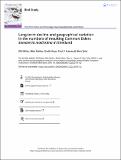Files in this item
Long-term decline and geographical variation in the numbers of moulting Common Eiders Somateria mollissima in Shetland
Item metadata
| dc.contributor.author | Miles, Will | |
| dc.contributor.author | Mellor, Mick | |
| dc.contributor.author | Gear, Sheila | |
| dc.contributor.author | Harvey, Paul V. | |
| dc.contributor.author | Tyler, Glen | |
| dc.date.accessioned | 2022-11-22T17:30:01Z | |
| dc.date.available | 2022-11-22T17:30:01Z | |
| dc.date.issued | 2022-11-22 | |
| dc.identifier | 281907108 | |
| dc.identifier | 9661b3e2-ba5d-4586-9ece-a0b97f88a78f | |
| dc.identifier | 85142430281 | |
| dc.identifier | 000888623100001 | |
| dc.identifier.citation | Miles , W , Mellor , M , Gear , S , Harvey , P V & Tyler , G 2022 , ' Long-term decline and geographical variation in the numbers of moulting Common Eiders Somateria mollissima in Shetland ' , Bird Study , vol. 68 , no. 4 , pp. 477-488 . https://doi.org/10.1080/00063657.2022.2141192 | en |
| dc.identifier.issn | 0006-3657 | |
| dc.identifier.uri | https://hdl.handle.net/10023/26467 | |
| dc.description | Funding: The 1977 survey was funded and led by the Nature Conservancy Council. Surveys from 1980 to 2019 were funded by the Sullom Voe Association and led by the Shetland Oil Terminal Environmental Advisory Group (SOTEAG). | en |
| dc.description.abstract | Capsule Numbers of moulting Common Eiders Somateria mollissima counted in Shetland during surveys from 1977 to 2019 decreased from approximately 14,500 to an estimated 3600 individuals, a 75% population decline. Aims To report results of extensive surveys of Eiders across Shetland during the annual complete moult period, review historical surveys, and evaluate long-term population changes and the possible underlying causes for change. Methods Extensive areas of coastal Shetland were surveyed for Eiders during the annual moult period from July to September, every one to five years from 1977 to 2019. Spatial sampling was variable between surveys from 1977 to 1993 but more systematic and standardised during all surveys from 1996 to 2019. Overall population change, changes in numbers of birds within areas categorised as either exposed or sheltered coast, and change in the proportion of adult males to females/juveniles were assessed. Results Surveys from 1977 to 1993 indicated a 55% decrease, from approximately 14,500–6500 individuals, and surveys from 1996 to 2019 showed a 45% decrease, from an estimated 6700–3600 individuals, indicating an overall population decrease of approximately 75% from 1977 to 2019. From 1996 to 2019, Eider numbers decreased in areas of exposed coast by approximately 90% but increased by at least 70% in the more sparsely populated sheltered areas, and the overall proportion of adult males to females/juveniles reduced by one-third. Conclusion From 1977 to 2019, a substantial decline of approximately 75% occurred in the Shetland Eider population at the time of moult. Shetland Eiders are not S. m. mollissima but morphologically and genetically akin to S. m. faeroeensis, the Faroese subspecies, the rarest subspecies worldwide, so this decline is of high conservation concern. Causes of the decline largely remain unknown, but ecological datasets on Shetland Eiders are few and detailed studies, including remote tracking of individuals’ movements throughout the year, would be worthwhile. | |
| dc.format.extent | 12 | |
| dc.format.extent | 1758773 | |
| dc.language.iso | eng | |
| dc.relation.ispartof | Bird Study | en |
| dc.subject | GC Oceanography | en |
| dc.subject | QH301 Biology | en |
| dc.subject | NDAS | en |
| dc.subject | MCC | en |
| dc.subject.lcc | GC | en |
| dc.subject.lcc | QH301 | en |
| dc.title | Long-term decline and geographical variation in the numbers of moulting Common Eiders Somateria mollissima in Shetland | en |
| dc.type | Journal article | en |
| dc.contributor.institution | University of St Andrews. Scottish Oceans Institute | en |
| dc.contributor.institution | University of St Andrews. School of Biology | en |
| dc.identifier.doi | 10.1080/00063657.2022.2141192 | |
| dc.description.status | Peer reviewed | en |
This item appears in the following Collection(s)
Items in the St Andrews Research Repository are protected by copyright, with all rights reserved, unless otherwise indicated.

